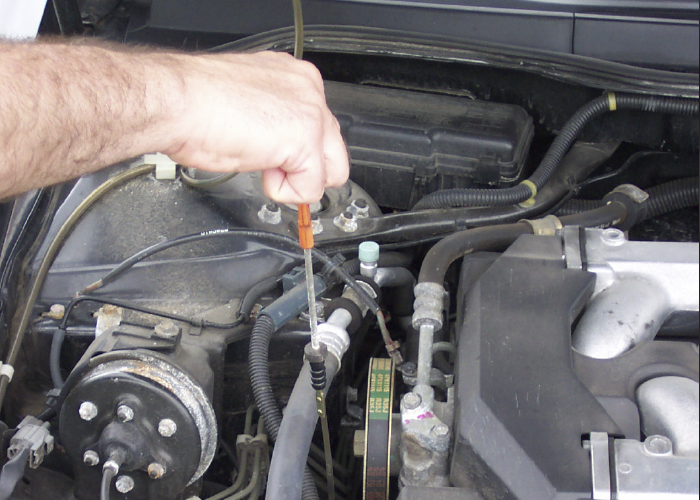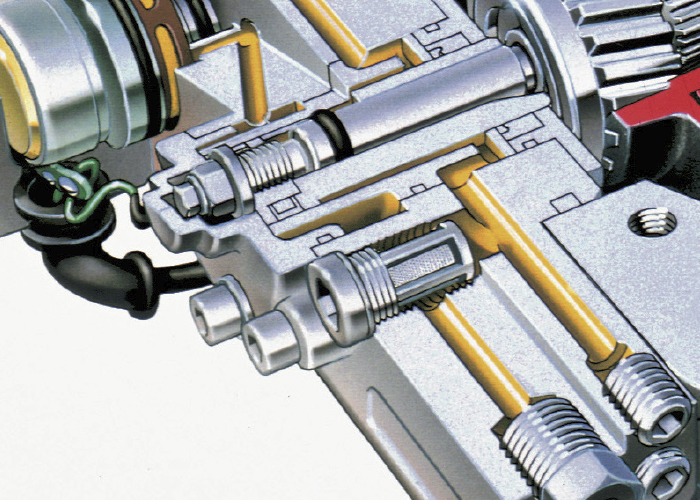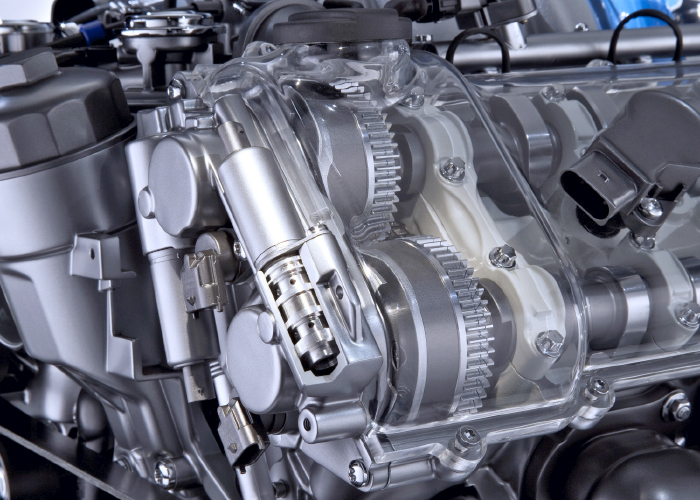An issue with the variable valve timing system can produce various symptoms, the most common of which are codes. The codes can indicate component failure or a condition where the actual commands do not result in the expected outcomes. It could be a code for an open circuit or an overly advanced or retarded camshaft. No matter the code, you must understand the code’s description and the criteria for setting the code.
On the mechanical side, the symptoms of a possible variable valve timing issue could be noise or a loss of power. It is rare that a failure will cause a no-start or no-crank condition. But, the state of the mechanical variable valve timing components can indicate other issues with the oil system of the vehicle.
When you are confronted with a variable valve timing problem, your diagnostic strategy needs to first focus on the supply of oil and then move outward to other possible problems.
Check the Oil Pressure
For a variable valve timing system to function, it must have oil pressure and enough volume. The most apparent inspection item is the oil level. If the oil level is low, the pump can suck in air, and the phasers and solenoids can’t function on air. They need oil pressure.
The other inspection item is oil pressure for the engine. If the pump is worn and can’t supply enough pressure, the phasers can’t unlock to change the timing of the camshafts. The camshaft position sensor will see this and set a code.
Most engines with variable valve timing no longer use a gerotor-style pump. Most engines use a variable displacement oil pump that changes the rotating axis of the outer gear. The gears of the inner rotor are replaced with variable-length vanes. The outer gear pivots on an axis; opposite the pivot is an electronic actuator. On mechanical versions, a spring replaces the actuator, and the opposite side of the housing has oil or a piston that pushes against the spring to regulate pressure.
These types of pumps control the pressure and volume of the oil being supplied to the variable valve timing components. This can add another layer to the diagnostic onion.
Check for Screens
There is debris inside every engine. It could be tiny chunks of carbon or large pieces of gasket material or sealers. While most debris can be captured by the oil filter or oil pick-up screen, some bits and pieces can make their way into the variable valve timing components.
Oil does not flow through these components like an engine bearing or lifter. The oil passages of a variable valve timing system are like a dead end, and the oil doesn’t flush out the passages all the time. If a piece of hard silicone finds its way into a phaser or oil control valve, it could be there for a while.
About every manufacturer has a metal screen filter to prevent debris in the oil from reaching the variable valve timing system. Some manufacturers make the screen serviceable but, on some vehicles, it could be inside the oil control solenoid and almost impossible to inspect or even clean. If the screen can be serviced, the procedure will be in the service information or TSB. Some manufacturers may recommend removing the filter screen.
The filters or screens are designed to catch the large pieces that can clog passages in the phasers and oil control valves. The screens are not designed to capture small pieces of debris.
The screens can be located in the oil galley leading to the valvetrain. Some screens are also located in the phaser or oil control valve.
Disconnect the oil control solenoid before scoping the camshaft and crankshaft waveform
If you are trying to determine if a timing chain has stretched or has jumped, you need to make sure the camshaft phasers are locked.
Most actuators have pins that slide into the actuator’s two parts when the oil pressure drops below a specific level. The pins prevent the camshaft from moving during startup when oil has not yet reached the top end of the motor.
If you measure the position of a camshaft relative to the crankshaft and the actuator is not locked, the waveform will not match a known-good waveform. The waveform may look like the chain has jumped or the sensor wheel is broken.
Look at the service information. For some VVT systems, the phasers can be locked using the bi-direction controls. Also, these controls can be used for diagnostics to confirm the operation of the oil control valves.
The Variable Valve Timing System is for Emissions
On many engines with variable valve timing actuators on the intake and exhaust camshafts, there will not be an EGR valve or secondary air injection system. If there are oxygen sensor issues, the system will not perform as designed. Both components have been replaced by the variable valve timing system. To provide an EGR function, the exhaust cam is fully retarded, which adds a lot of overlap. As a result, the exhaust gas remains trapped in the cylinder. This detail allows a reduction in hardware and service issues from carbon.
Opening the exhaust valve later retains more exhaust pressure in the cylinder, causing pushback to the intake charge and exhaust gas retention. On some systems, the intake camshaft is advanced at part throttle and WOT. The intake valve opens sooner and allows exhaust gas into the intake stroke, which has an EGR effect. Engines can also use valve overlap to allow extra oxygen to reach the catalytic converters. This extra oxygen and fuel can help the catalyst get up to temperature sooner to reduce startup emissions. If you have a vehicle with oxygen or catalyst efficiency codes, they might be related to the variable valve timing system.
Power and Grounds
Variable valve timing systems use sensors and actuators. A bad ground can cause the sluggish performance of the oil control solenoid. Resistance in the wiring to a sensor can cause a code or make for a lousy waveform.
Use the service information
As you might have already guessed, VVT diagnostics are very application specific. VVT diagnostics not only depend on whether the engine is an in-line or V-type block, or a SOHC or DOHC configuration, but also the configuration of the phaser and system electronics. Also, there are dozens of “global” P0010- and P0340-series trouble codes, not to mention manufacturer-specific P1000-series codes, that can be stored due to a valve-timing problem. But, by applying basic operating principles, it’s possible to diagnose most VVT failures, regardless of configuration.
Rule out the Oil and Filter
Engine oil viscosity and oil filter flow can affect the ability of the cam phaser to control valve timing, as can the service life ratings of the oil. Changes in the viscosity from a 5W20 to a 5W30 oil can cause issues with the variable valve timing system. You might want to change the oil before continuing with additional diagnostics.
Variable Timing Happens All the Time
Early variable valve timing systems were active only in higher rpm ranges and under specific conditions. Late-model systems are actively adjusting the positions of the intake and exhaust camshafts for the best possible efficiency. Using a scan tool to watch the live data during the test drive can be helpful. Some vehicles have data PIDs for both the actual and targeted/desired position.
The most important diagnostic strategy with variable valve timing complaints is to confirm the knowns and unknowns. Being able to follow the flow of oil from the pan to the phaser is just as critical as knowing the flow of current from the ECM to the oil control solenoid. Replacing parts like phasers and oil control solenoids will only result in a false positive.

















